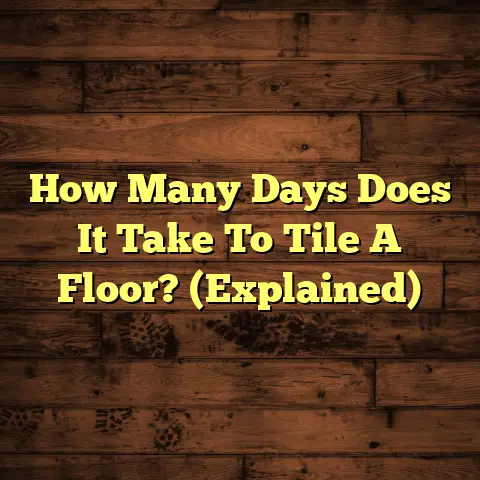Bed Rolling On Wood? (6 Stops You’ll Love!)
Ever wake up feeling like you’ve been sailing the high seas all night, only to realize your bed’s been migrating across your beautiful wooden floor?
I get it. As a flooring contractor for over 15 years, I’ve seen this issue more times than I can count.
Wooden floors are timeless, right? They bring warmth, elegance, and a touch of nature indoors.
But that charm can quickly fade when your bed starts doing the cha-cha across the room.
Don’t worry, I’m here to help you anchor that bed and keep your floors looking pristine.
Let’s dive into why this happens and, more importantly, how to fix it with these six stops you’ll absolutely love!
The Problem of Bed Rolling
Understanding Bed Rolling on Wood
So, what exactly is “bed rolling”?
It’s when your bed, seemingly of its own accord, decides to take a little trip across your wooden floor.
This is super common, especially on smooth surfaces like hardwood, laminate, or even engineered wood.
Why does it happen? Several factors are at play:
- Bed Frame Type: Lightweight metal frames are notorious for this.
- Mattress Weight: A heavy mattress on a light frame? Recipe for rolling!
- Floor Smoothness: The smoother the floor, the easier it is for the bed to move.
- Slight Inclines: Even a barely noticeable slope in your floor can encourage movement.
- Natural Wood Movement: Wood expands and contracts with humidity changes, which can subtly shift the floor beneath your bed.
Impact on Aesthetics and Functionality
Bed rolling isn’t just a minor annoyance; it can actually impact your home’s aesthetics and functionality.
Imagine this: you’ve perfectly arranged your bedroom, only to find your bed gradually drifting away from the headboard.
- Disrupted Visual Harmony: It throws off the balance of the room, making it look unintentionally messy.
- Floor Scratches: Constant movement can scratch and damage your beautiful wooden floors. Ouch!
- Annoying Noises: The creaking and groaning as the bed moves can be a real sleep disruptor.
- Safety Hazard: In extreme cases, the bed could roll into objects or even block doorways.
- Reduced Space: The rolling can make the room smaller.
The Importance of Addressing Bed Rolling
Preserving Your Investment
Let’s be real, wooden floors are an investment.
According to HomeAdvisor, the average cost to install hardwood floors ranges from $6 to $12 per square foot.
That’s not chump change! Ignoring bed rolling can lead to:
- Premature Wear: Constant friction wears down the finish and the wood itself.
- Costly Repairs: Scratches can require refinishing, which can be expensive.
- Reduced Home Value: Damaged floors can negatively impact your home’s resale value.
Taking proactive steps to prevent bed rolling is like buying insurance for your floors.
It protects your investment and keeps your home looking its best for years to come.
Enhancing Sleep Quality
A stable bed isn’t just about aesthetics; it’s about your sleep!
Think about it:
- Reduced Disturbance: A bed that stays put minimizes creaks and shifts that can wake you up.
- Improved Comfort: Knowing your bed is stable allows you to relax and sleep more soundly.
- Better Spinal Alignment: A stable surface helps maintain proper spinal alignment throughout the night.
According to the CDC, adults need at least 7 hours of sleep per night for optimal health.
A stable bed can contribute to achieving that goal, leading to improved mood, energy levels, and overall well-being.
Six Stops to Love
Alright, let’s get to the good stuff!
Here are six tried-and-true methods to stop your bed from rolling, each with its own unique benefits.
1. Furniture Coasters
Furniture coasters are simple, affordable, and surprisingly effective.
They act as a buffer between the bed legs and the floor, preventing direct contact and reducing friction.
- Rubber Coasters: These provide excellent grip and are ideal for heavier beds. They’re also moisture-resistant, perfect for humid climates.
- Felt Coasters: Great for lighter beds and delicate floors. They glide smoothly, preventing scratches.
- Silicone Coasters: Offer a balance of grip and glide. They’re also heat-resistant, making them suitable for use near radiators.
How to Use:
- Lift each bed leg slightly.
- Place a coaster underneath each leg, ensuring it’s centered.
- Lower the bed gently.
Pro Tip: Choose coasters that are slightly larger than the bed legs for maximum stability.
2. Bed Frame Modifications
Sometimes, a little DIY ingenuity is all you need.
Here are a few simple modifications you can make to your bed frame:
- Rubber Grips: Attach rubber grips to the bottom of the bed legs. You can find these at most hardware stores.
- Adjustable Leg Levelers: If your floor is uneven, install adjustable leg levelers to ensure all legs are making even contact with the floor.
- DIY Leg Wraps: Wrap the bed legs with non-slip material like shelf liner or rubber tape.
DIY Solution Example:
I once helped a client who had a beautiful antique bed frame that kept rolling.
We wrapped the legs with strips of leather and secured them with decorative tacks.
Not only did it stop the rolling, but it also added a touch of vintage charm!
3. Weighted Bed Skirts
This is a clever and stylish solution that many people overlook.
A weighted bed skirt is essentially a regular bed skirt with added weight along the bottom hem.
This extra weight helps anchor the bed and prevent it from moving.
- Materials: Look for bed skirts made from heavy fabrics like canvas, denim, or even velvet.
- Designs: Choose a design that complements your bedroom décor. A classic, tailored skirt works well with traditional styles, while a ruffled skirt adds a touch of romance.
- DIY Option: You can even create your own weighted bed skirt by sewing small weights (like metal washers or fabric-covered lead weights) into the hem of an existing bed skirt.
Pro Tip: Make sure the bed skirt is long enough to reach the floor. This maximizes its anchoring effect.
4. Non-Slip Mats
These are similar to furniture coasters, but they offer a larger surface area and often provide a stronger grip.
They’re specifically designed to prevent furniture from sliding on hard surfaces.
- Materials: Look for mats made from rubber, PVC, or foam. These materials provide excellent traction.
- Sizes: Choose mats that are slightly larger than the bed legs.
- Installation: Simply place the mats under each bed leg.
Bonus: Non-slip mats can also help absorb vibrations and reduce noise.
5. Securing the Bed to the Wall
This is a more permanent solution, but it provides the ultimate stability.
Anchoring your bed frame to the wall prevents it from moving in any direction.
- Pros: Unmatched stability, especially useful for platform beds or beds with headboards.
- Cons: Requires drilling into the wall, may not be suitable for renters, can be difficult to move the bed later.
How to Install:
- Locate the wall studs behind your bed.
- Use a stud finder to ensure accurate placement.
- Attach metal brackets to the bed frame and the wall studs using screws.
- Connect the brackets with bolts or screws.
Safety First: Always use appropriate hardware and follow manufacturer instructions.
If you’re not comfortable with DIY projects, consider hiring a professional handyman.
6. Choosing the Right Bed Frame
Sometimes, the best solution is to start from scratch.
When shopping for a new bed frame, consider the following factors:
- Weight: Choose a frame made from sturdy materials like solid wood or heavy-gauge metal.
- Design: Platform beds with a low center of gravity tend to be more stable than traditional bed frames with legs.
- Leg Placement: Look for frames with legs that are widely spaced and positioned towards the corners of the bed.
- Headboard Connection: A headboard that is securely attached to the frame can add extra stability.
Style Comparison:
| Bed Frame Style | Stability | Aesthetics |
|---|---|---|
| Platform Bed | Excellent | Modern, Minimalist |
| Sleigh Bed | Good | Classic, Elegant |
| Metal Frame Bed | Fair | Industrial, Modern |
| Canopy Bed | Fair | Romantic, Dramatic |
Aesthetic Considerations
Design Harmony
Let’s face it, practicality is important, but aesthetics matter too!
The good news is that all of these solutions can be implemented without sacrificing style.
- Coasters: Choose coasters that blend in with your floor color or complement your bed frame.
- Bed Skirts: Select a bed skirt that matches your bedding and overall bedroom décor.
- Non-Slip Mats: Hide them under the bed legs or choose clear mats that are virtually invisible.
- Wall Anchors: Conceal the brackets behind the headboard or use decorative covers.
Color and Material Coordination
To create a cohesive look, pay attention to color and material coordination.
- Wood Floors: Choose furniture and accessories that complement the warm tones of the wood.
- Light Floors: Opt for darker furniture to create contrast.
- Dark Floors: Use lighter furniture to brighten up the space.
Example: If you have a dark walnut floor, consider using a light-colored bed frame with a linen headboard and a cream-colored bed skirt.
This will create a balanced and inviting atmosphere.
Real-Life Applications and Case Studies
Homeowner Experiences
I’ve seen these solutions work wonders for countless clients.
Here are a few examples:
- Sarah, a homeowner with a beautiful but slippery laminate floor: She used rubber coasters under her bed legs and noticed an immediate improvement. “My bed used to roll halfway across the room,” she said. “Now, it stays put!”
- Mark, a renter with a lightweight metal bed frame: He wrapped the legs with non-slip shelf liner and secured them with tape. “It’s not the prettiest solution,” he admitted, “but it works like a charm, and my landlord hasn’t noticed!”
- Emily, a design enthusiast with a classic sleigh bed: She invested in a weighted bed skirt made from velvet. “It adds a touch of luxury to my bedroom,” she said, “and it keeps my bed from rolling on my hardwood floors.”
Professional Insights
I asked a few of my interior designer friends for their thoughts on bed rolling.
Here’s what they had to say:
- “Bed rolling can ruin the entire look of a room,” said interior designer, Maria. “It’s important to address it not only for practical reasons but also for aesthetic ones.”
- “I always recommend using furniture coasters or non-slip mats,” said interior designer, David. “They’re simple, effective, and relatively inexpensive.”
- “For clients who are committed to stability, I suggest anchoring the bed to the wall,” said interior designer, Jessica. “It’s a more involved process, but it provides the best results.”
Conclusion: The Lasting Impact of Stability on Comfort
Wooden floors are a timeless choice that can add beauty and value to your home.
But bed rolling can detract from their appeal and disrupt your sleep.
By implementing these six stops, you can enjoy the best of both worlds: the elegance of wooden floors and the stability of a well-anchored bed.
Remember, a stable bed contributes to a better sleep environment, leading to improved health and well-being.
So, take the time to address bed rolling and create a harmonious and timeless bedroom space that you’ll love for years to come.
Which of these solutions are you most excited to try? Let me know in the comments below!





